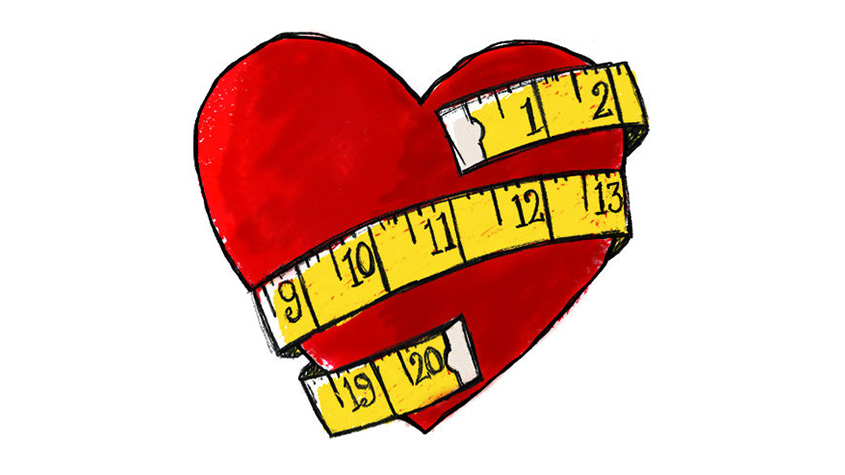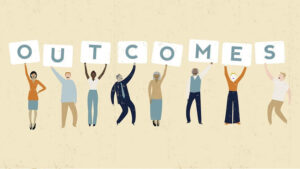
SROI revolution or evolution?
A growing emphasis on developing rich theories of change, being pragmatic about what data to collect, and increasing sophistication in valuing outcomes has put SROI at the forefront for how society can better account for what really matters.

- At the core of the evolution of Social Return on Investment (SROI) over the past 10 years is the belief that society needs to change how we account for value.
- Over this time, there has been a growing focus on organisations using SROI to inform how they manage their activities, outcomes and impact instead of simply producing an SROI report.
- The evolution of SROI can be largely attributed to a growing sophistication in understanding, measuring and valuing change.
Listen to the podcast: SROI evolution or revolution?
Over the last 10 years, Social Return on Investment (SROI) has evolved. At the core of this evolution is the belief that society needs to change how we account for value.
We currently have legislation, systems, investment and sophisticated mechanisms to account for cash in our society. We have balance sheets, profit and loss statements, and cash flow statements, and management attention is dedicated to interrogating and managing the risks that arise from this information.
SROI explicitly accounts for value, especially social value, and addresses the power imbalances in our society…”
But we don’t have the right systems in place to account for the stuff that really matters – the effect our policies, funding and services have on society: the positive and the negative; the intended and the unintended; and the short and long term. For example, how does affordable housing impact families and communities? And equally important is who we ask to inform what gets measured and valued. What are the effects on children in out of home care, and how should we engage with the children to understand what matters to them?
The SROI framework provides a structure for systematically accounting for changes. SROI explicitly accounts for value, especially social value, and addresses the power imbalances in our society, by providing a voice to those who are experiencing the changes.[1]
Global context
Just over 10 years ago, the original SROI Network formed in the UK. At that time, SVA played an integral role in developing and applying SROI in Australia. The Network enabled people who were working on SROI to develop and share their philosophical perspectives and technical approaches for how to account for value.
There has been more of a focus on organisations managing the activities, outcomes and impact… ”
In 2014, the SROI Network merged with the Social Impact Analyst Association (SIAA) to form Social Value International (SVI). This reflected the increasing maturity of SROI and how it was starting to gain wider appeal and use across sectors and geographies. As a result of this shift, there has been more of a focus on organisations managing the activities, outcomes and impact instead of simply producing an SROI report. (A report is often a statement or a snapshot about what has happened at a specific time.)
This evolving focus on impact management can be seen through SVI’s involvement in projects with the World Business Council for Sustainable Development and the Impact Management Project. The seven Principles of Social Value provides guidance to support how stakeholder voices can be incorporated, especially for businesses and investors, and to account for unintended and negative outcomes.
From analysis to accounting for social value
When SROI first started, the emphasis was on ‘doing’ SROI analyses. It was viewed as an analytical tool that would help the social sector value social outcomes. Over time and as more practitioners started to use the SROI framework, the philosophy and framework behind SROI evolved.
Informing and making decisions, and providing a voice to those who are experiencing the changes, to help deliver more social value is the focus… ”
There has been increasing recognition that the seven Principles of Social Value can be applied in many different contexts. For example, SROI is increasingly being used as a learning framework to improve decision making about social programs, which will ultimately affect the people who use these programs. An example of this is SVA Consulting’s work with Te Whānau O Waipareira, in New Zealand, where the Social Value principles have guided their transition to a learning culture based on outcomes and value.
In addition, there has been growing appreciation that SROI was not (and could not be) precise – which is similar to other social science methodologies. SROI highlights critical questions about what changes mattered, how to measure them, and how valuable they were, so that we could have better data for making decisions about allocating resources.
In 2014, we outlined how the SROI framework had evolved so that it could be applied to understand the effectiveness and efficiency of any investment, program or organisation – without doing a full SROI report (see Getting the most out of SROI). This still holds true. Informing and making decisions, and providing a voice to those who are experiencing the changes, to help deliver more social value is the focus – rather than just delivering a report.
To understand, measure and value changes, we need to consider the following three questions:
- Purpose: What is the reason for doing this piece of work?
- Audience: Who do I need to share this work with or convince?
- Rigour: How far do I need to go to get a meaningful answer?
We have seen how this framing can support practical and careful deliberation about how best to use the SROI framework and Social Value principles. The evolution of SROI can be largely attributed to a growing sophistication in understanding, measuring and valuing change.
It is important to note that there has been progress in how the ‘investment’ part of SROI has been accounted for, but the substantial changes have been in how we understand, measure and value outcomes. The focus of the remainder of this article will be on how each of these three areas have evolved.
Understanding change
Understanding what changes, and who experiences those changes, is a part of SROI that is consistently applauded, and a cornerstone of the SROI revolution.
… involving stakeholders means that the theory of change that is produced is viewed as authentic, and a rich causal tapestry of the complexity of how people experience change. ”
Once the audience, purpose and rigor have been determined for a SROI related project, or a piece of analysis, the first substantial step is to understand what changes, and for whom.
The Social Value principle of involving stakeholders means that the theory of change that is produced is viewed as authentic, and a rich causal tapestry of the complexity of how people experience change. For example, the work SVA Consulting has done with the Department of the Prime Minister and Cabinet for the Indigenous Protected Areas exemplifies how to incorporate complex ideas such as the inextricable interconnection between a healthy country and healthy people.[2]
Similarly, the outcomes identified for Martu, the traditional custodians of a vast area of the Western Deserts of the Pilbara in Western Australia, showed a similar level of sophistication in telling the ‘real’ story for Martu and their communities.[3]
The SROI methodology was used to help refine a theory of change for the Martu Leadership Program where the positive outcomes were described as a ‘platform’ for changes that are likely to occur in the future. This reflects the reality of building capacity in communities. It takes time – you can’t just get ‘outcomes’ the community wants in a three year pilot program, even if, as in this case, Kanyirninpa Jukurrpa (KJ) have spent decades building trust and the capacity of the communities.
Putting the building blocks in place that will make future outcomes possible represents important progress, which needs to be understood, acknowledged and valued by decision-makers.
The ability to genuinely listen and appropriately respond to people and their communities is central to understanding and delivering the right investments and programs. ”
In each of these examples, the SROI methodology provided the structure and permission for having conversations with stakeholders about what really matters. For investors, policy makers and managers, appreciating the richness of the story of change helps inform better decision making and supports a more equitable power dynamic, especially in Indigenous communities.
These developments are recognition that wanting to do good is simply not enough; the ability to genuinely listen and appropriately respond to people and their communities is central to understanding and delivering the right investments and programs.
Measuring change
Developing a story of change is critical, but we need to know if the changes are happening or not (or are likely to happen or not). Measuring or observing these changes remains a controversial part of the SROI framework, largely because it is dependent on the development and use of tools that are not overtly prescribed as a part of the SROI framework. SROI is a principles based approach, and we need to use specific tools to measure or observe changes for different people.
This is a problem faced across the research and academic fields in social policy: How far is good enough? What evidence is good enough? ”
These challenges have manifest through questions about rigour, that is, ‘How far do I need to go to get a meaningful answer?’. Some SROI analyses focus on collecting anecdotal evidence through conversations and interviews with stakeholders. Others may collect data over time with validated research tools and techniques that are considered rigorous. This is a problem faced across the research and academic fields in social policy: How far is good enough? What evidence is good enough?
The best examples SVA has worked on are where we first work with an organisation to develop a forecast SROI analysis (which is where we predict what is likely to change for different stakeholders, how valuable it is, based on an investment) and then work through an evaluative SROI years later, to validate the claims that were made (for example, see STREAT and Spinal Cord Injuries Australia, in Extended benefits of an SROI report).
We have also seen how the SROI process can build over time, and use evidence gathered over a long period. For example, SVA Consulting is currently working with the Department of the Prime and Minister and Cabinet and Indigenous Ranger groups across the country to develop a shared and flexible outcomes framework, which builds on the SROI work completed over the past seven years across the country.
Another example is the SROI analysis we completed for the Mirabel Foundation, an organisation in Australia specifically addressing the needs of children who have been orphaned or abandoned due to parental drug use. In this example, we were able to look back on eight years of data across all of Mirabel’s activities for young people.[4] This is the power of the SROI framework in being able to measure what matters, even if it is complex and over the long term.
We can, and should, push towards getting better data and insights… But ultimately we need the best information we have, now, to make better decisions now. ”
Most of the time when we are measuring or observing change, we are trying to understand what the changes are at the same time. This is the reality and a function of research projects having limited resources and historical data.
It also reflects how programs (and people) change over time. Despite a desire for SROI projects to use data that has been collected over a long time, this is inherently difficult, and therefore most SROI related projects use data that has been collected for a specific group of people over a short period of time, often during a single project.
And this is OK! We can, and should, push towards getting better data and insights into the programs that we manage and fund. But ultimately we need the best information we have, now, to make better decisions now.
That is why SIMNA (Social Impact Measurement Network of Australia), the Australian national member network of SVI, encourages people, wherever they are on their measurement journey, to improve their impact management practices to grow positive social impact. This has been a guiding philosophy for SVA Consulting when we work with organisations too – let’s do something now to understand if you are creating value or not, and let’s work through how we can improve this over time.
Valuing change
Part of the appeal of SROI has been the numbers: the numbers used to value outcomes, and the SROI ratio. The merger of the two networks which resulted in SVI agreed on the seven Principles of Social Value as a foundation for how we can account for value, including ‘Value the things that matter’.
… other social impact reports can apply this principle without using financial proxies. ”
However, an important evolution occurred – the need to use financial proxies, which was traditionally a part of SROI, is only relevant for SROI analyses and reports – other social impact reports can apply this principle without using financial proxies.
This has opened up more ways to interpret and use this principle in practice. In particular, there is an increasing emphasis on describing the relative importance of outcomes before using financial proxies to value outcomes. This helps to give the valuations more reference points, especially as we try to value outcomes which often don’t have a market value.
For example, a common outcome identified for many people through social programs is ‘increased self-confidence’. Before we use a financial proxy to value the outcome, we need to know the relative importance of this outcome: is it more important than earning more money, or is it less important than developing closer connections with your family. By looking at other reference points, we can be more rigorous in our use of financial proxies to value outcomes.
However, the evolution of valuation has also led to more caution in using financial proxies. In some instances, they have been avoided if the message would detract from the intended purpose of the report.
For example, in the Martu Leadership Program SROI analysis for KJ described above, despite the fact we were conducting an SROI evaluation, we deemed it inappropriate to use financial proxies to value the creation of a ‘platform’ that would enable Martu communities to discuss and address social issues.[5]
To use financial proxies to value this intermediate outcome would have been a misrepresentation because it wasn’t far enough down the causal chain of events that Martu want to experience: it is a platform that will allow changes to occur over the next generation. To calculate an SROI ratio in this example would have been inappropriate as it would have distracted from the most important part of the story, the creation of a platform for Martu to redefine their lives and communities.
Another example is a forecast SROI analysis SVA supported Te Whānau O Waipareira with for the Taitamariki Program, the first SROI analysis for Māori by Māori.[6]
This program is a unique preventative mental health program for 10-13 year olds in West Auckland, delivered at various locations during school or after school hours.
The sessions cover the harms and consequences associated with drug and alcohol, awareness of mental health and healthy lifestyles, relationships with whānau (family) and crime.
There is lots of value created for taitamariki (young people) and whanau (families). The potential benefits to the government associated with improved mental health of taitamariki are significant as the consequential costs to the government in the future are reduced.
However, in this analysis, and in accordance with the Social Value principle of not over-claiming, the value of government outcomes was not included as there are numerous factors that could influence the lives of these people.
But, if a link between the Taitamariki Program and government savings can be proven, even for a small number of participants, the value created is likely to be significant.
Further evidence will be required to prove this link, but it highlights how the Social Value principles can be used to only include what is material based on a specific investment and time period.
This is a sign that data, and valuations, are being shared to help gain more consistency in how we account for social value. ”
Another evolution in valuation is the Australian Social Value Bank (ASVB), which was released in 2017. This was built off the back of the HACT Social Value Bank in the UK. The ASVB is a collection of social values and a value calculator.
The values are derived through a technique known as ‘wellbeing valuation’ (WV). WV is based on life satisfaction and is calculated by taking data from subjective wellbeing surveys and matching it to the conditions in the respondent’s life, such as age, socio-economic status and gender, to derive a value through econometric analysis.
This approach has many benefits as it overcomes the problems of asking individuals directly how they value an outcome, so it is therefore cost effective. But it also needs to be treated with caution as the values need to relate to the specific stakeholder group and the outcome you want to value: there may be important differences between your population and the population that was surveyed for the WV data.
This approach has encouraged much needed debate about the purpose and rigour of valuation of social outcomes.
SVI has been managing a fabulous resource called the Global Value Exchange (GVE). Its evolution is also an indicator of how the SROI framework has evolved. There are over 30,000 social impact measurement metrics on the GVE, including stakeholders, outcomes, indicators and valuations.
Historically, GVE had aggregated data that was produced through SROI reports; but now the GVE includes datasets from the HACT Social Value Bank, Big Society Capital’s Outcome Matrix, the UN Global Goals for Sustainable Development, the Global Reporting Initiative and many others.
This is a sign that data, and valuations, are being shared to help gain more consistency in how we account for social value. We must still remember how to engage stakeholders in the process (it is a Social Value principle, after all), but this evolution is promising as SROI and impact management practices evolve.
The future
The SROI movement has given a voice to those who otherwise may not have had a chance to have their story heard about what has changed, and its value.
The evolution over the past decade may not be a revolution, but the foundation is set for how we can better account for value and make better decisions about the stuff that really matters.

About the author
Simon Faivel is a Director at SVA Consulting, an accredited SROI practitioner and trainer, Chair of the Social Impact Measurement Network of Australia (SIMNA) and co-Chair of Social Value International (SVI).
For more information contact the consulting team.
[1] People, power and accountability, Stanford Social Innovation Review, Jeremy Nicholls, June 2014
[2] Social Return on Investment analysis of the Warddeken Indigenous Protected Area and associated Indigenous ranger programme, Department of the Prime Minister and Cabinet, February 2016 (see pages 23 to 26)
[3] The Martu Leadership Program, Evaluation of a pilot program using the Social Return on Investment/SROI methodology, SVA Consulting, April 2017
[4] The Mirabel Foundation Inc. Baseline Social Return on Investment analysis of Mirabel’s Victorian activities, SVA Consulting, October 2015
[5] The Martu Leadership Program, Evaluation of a pilot program using the Social Return on Investment/SROI methodology, SVA Consulting, April 2017
[6] Value Creation by Taitamariki Programme, Te Whānau O Waipareira, June 2017










